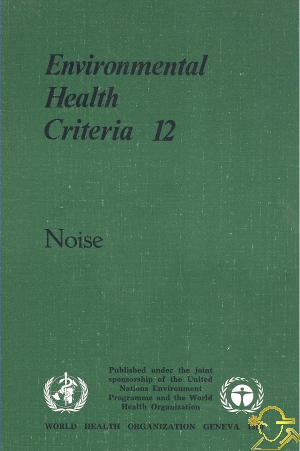Environmental Health Criteria 1 2
İÇİNDEKİLERENVIRONMENTAL HEALTH CRITERIA FOR NOISE1. SUMMARY AND RECOMMENDATIONS FOR FURTHER 1.1 Summary 1.1.1 Introduction 1.1.2 Noise measurement 1.1.3 Effects of noise 1.1.3.1 Interference with communication 1.1.3.2 Hearing loss 1.1.3.3 Disturbance of sleep 1.1.3.4 Stress 1.1.3.5 Annoyance 1.1.3.6 Effects on performance 1.1.3.7 Miscellaneous effects1 1.1.4 Summary of recommended noise exposure limits 1.2 Recommendations for further studies 2. PROPERTIES AND MEASUREMENT OF NOISE 2.1 Physical properties and measurements 2.2 Sound perception and its measurement 2.2.1 Loudness and loudness level 2.2.2 Calculation and measurement of loudness level 2.2.3 Sound level and noise level 2.2.4 The time factor 2.2.5 Noise exposure scales 2.2.6 Equivalent continuous sound pressure level 2.2.7 Level distribution 2.3 Sources of noise 2.3.1 Industry 2.3.2 Road traffic 2.3.3 Rail traffic 2.3.4 Air traffic 2.3.5 Sonic booms 2.3.6 Construction and public works 2.3.7 Indoor sources 2.3.8 Miscellaneous sources 3. EFFECTS OF NOISE 3.1 Noise-induced hearing loss 3.1.1 Hearing impairment 3.1.1.1 Hearing level, noise-induced threshold shift, and hearing impairment 3.1.1.2 Noise-induced temporary threshold shift 3.1.1.3 Noise-induced permanent threshold shift 3.1.1.4 Incidence of noise-induced permanent hearing loss 3.1.2 Relation between noise exposure and hearing loss 3.1.2.1 Laboratory studies 3.1.2.2 Occupational hearing loss 3.1.2.3 Factors that may influence the incidence ofnoiseinduced permanent threshold shift 3.1.2.4 Combined effects of intensity and duration of Noise exposure 3.1.2.5 Estimation of hearing impairment risk 3.1.2.6 The importance of high-frequency hearing 3.1.3 Effects of impulsive noise 3.1.4 Infrasound and ultrasound 3.2 Interference with communication 3.2.1 Masking and intelligibility 3.2.2 Speech interference indices 3.2.2.1 Articulation index 3.2.2.2 Speech Interference Level 3.2.2.3 A-weighted sound pressure level 3.2.3 Perception of speech out-of-doors 3.2.4 Indoor speech communication 3.3 Pain 3.4 Sleep 3.4.1 Nature of sleep disturbance 3.4.2 Influence of noise characteristics 3.4.3 Influence of age and sex 3.4.4 Influence of previous sleep deprivation, adaptation, and motivation 3.4.5 Long-term effects of sleep disturbance by noise 3.5 Nonspecific effects 3.5.1 The stress response 3.5.2 Circulatory system responses 3.5.3 The startle reflex and orienting response 3.5.4 Effects on equilibrium 3.5.5 Fatigue 3.6 Clinical health effects 3.6.1 Background 3.6.2 General health 3.6.3 Mental health 3.7 Annoyance 3.7.1 Definition and measurement 3.7.2 Instantaneous noise dose 3.7.3 Long-term noise dose 3.7.3.1 Aircraft noise 3.7.3.2 Road traffic noise 3.7.3.3 General environmental noise 3.7.4 Correlation between noise exposure and annoyance 3.7.5 Overt reaction 3.8 Effects on task performance 3.8.1 Noise as a distracting stimulus 3.8.2 Effects on tasks involving motor or monotonous activities 3.8.3 Effects on tasks involving mental activities 4. EVALUATION OF HEALTH RISKS TO MAN FROM EXPOSURE TO NOISE 4.1 Environmental noise 4.2 Populations affected 4.3 Specific health criteria 4.3.1 Physical injury 4.3.2 Hearing loss 4.3.3 Nonspecific health effects 4.3.4 Interference effects 4.4 General health, welfare, and annoyance criteria 5. NOISE CONTROL AND HEALTH PROTECTION 5.1 Noise control at source 5.2 Control of sound transmission 5.3 Reduction in length of exposure 5.4 Education of workers 5.5 Ear protection 5.6 Audiometry REFERENCES    |



